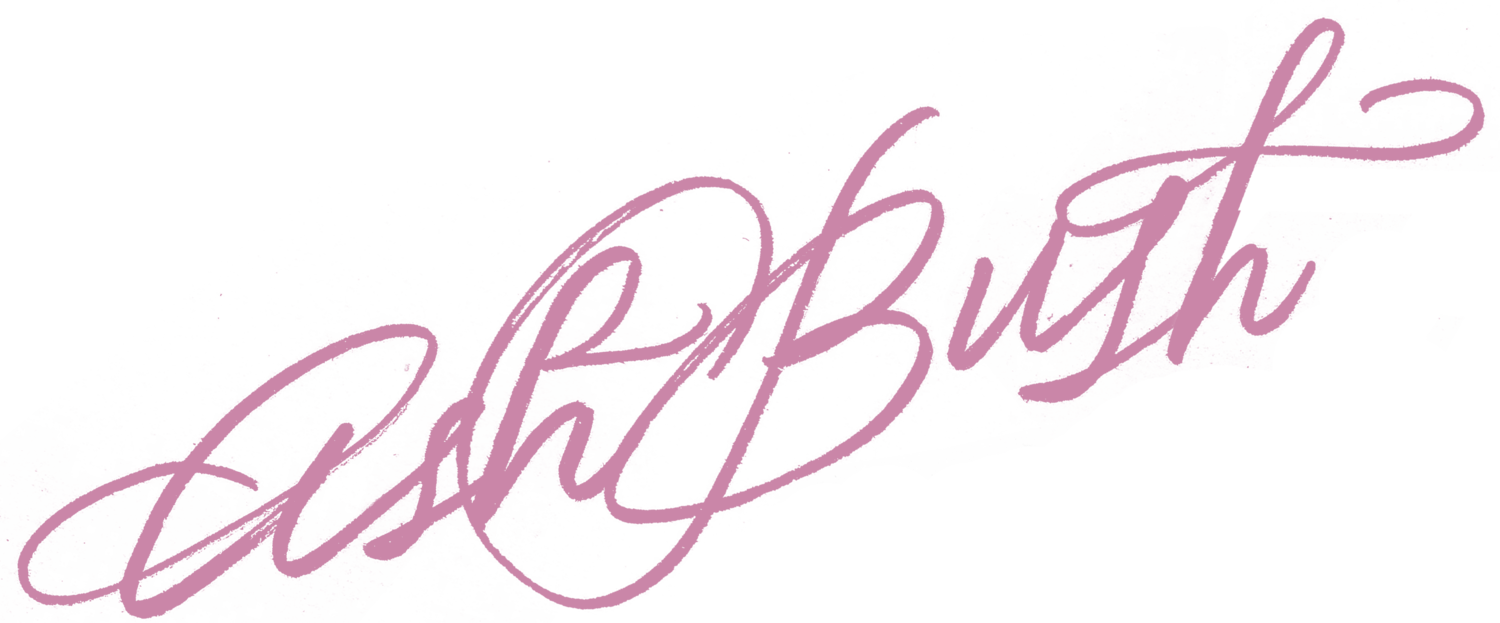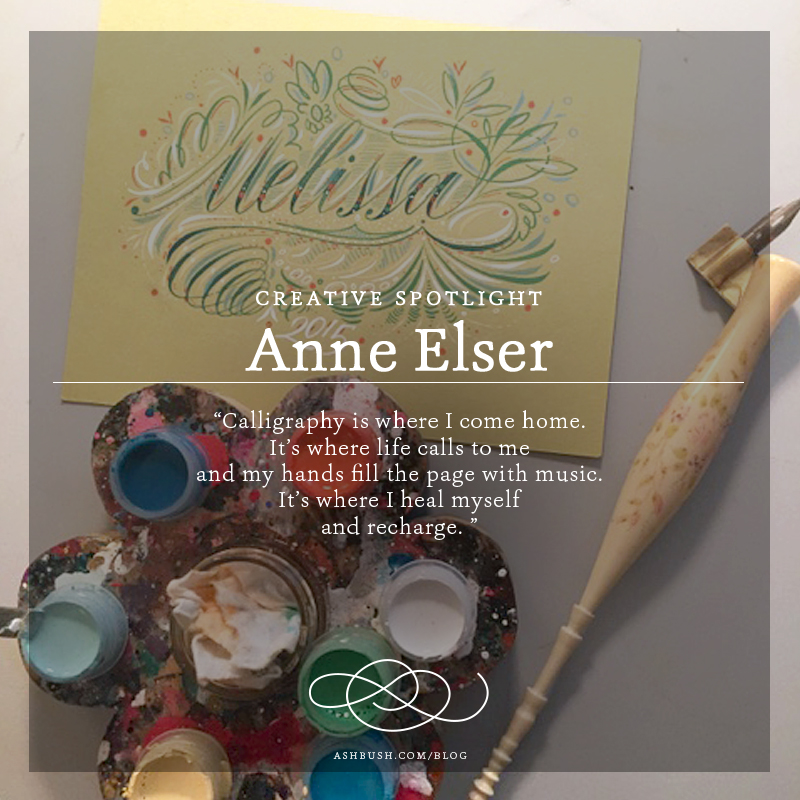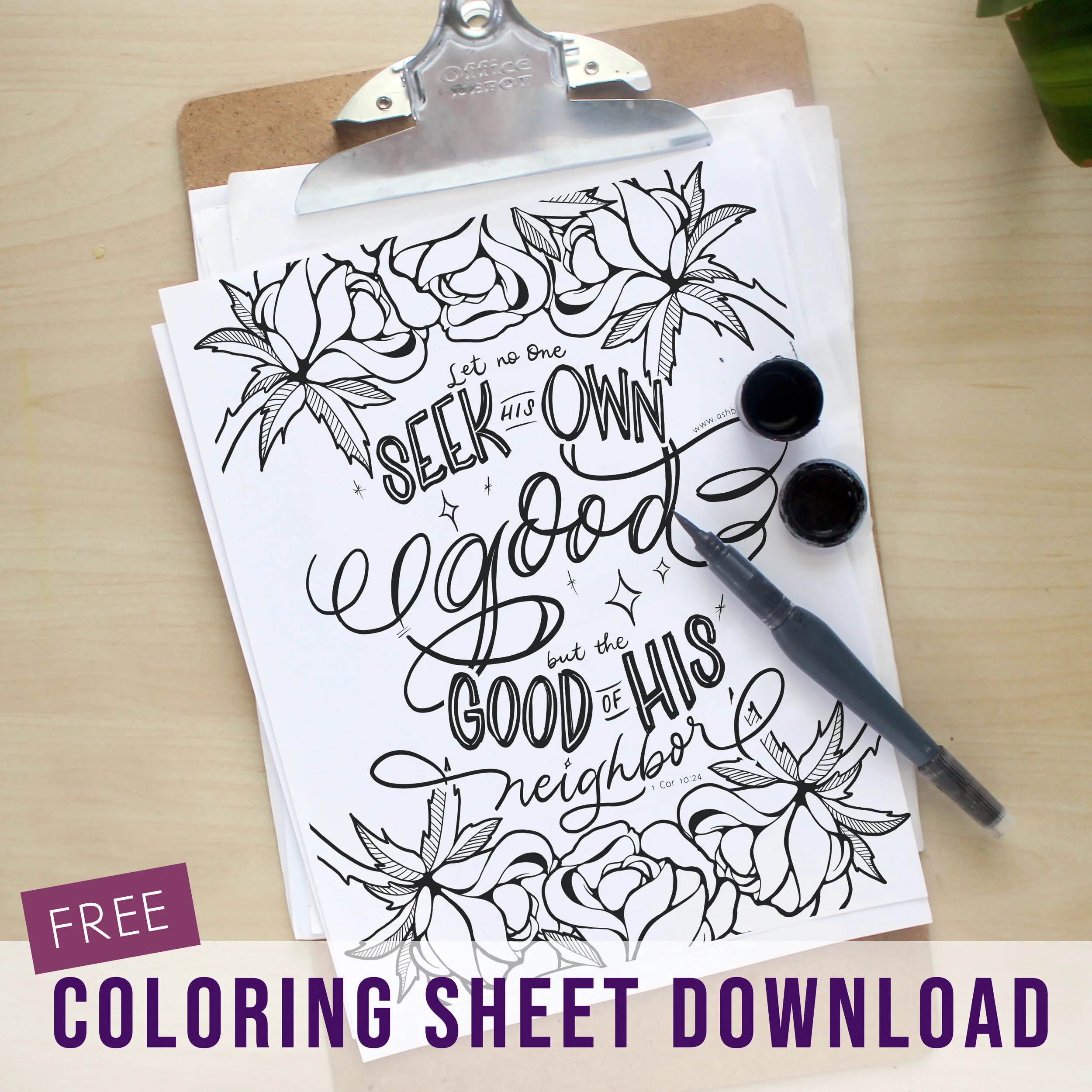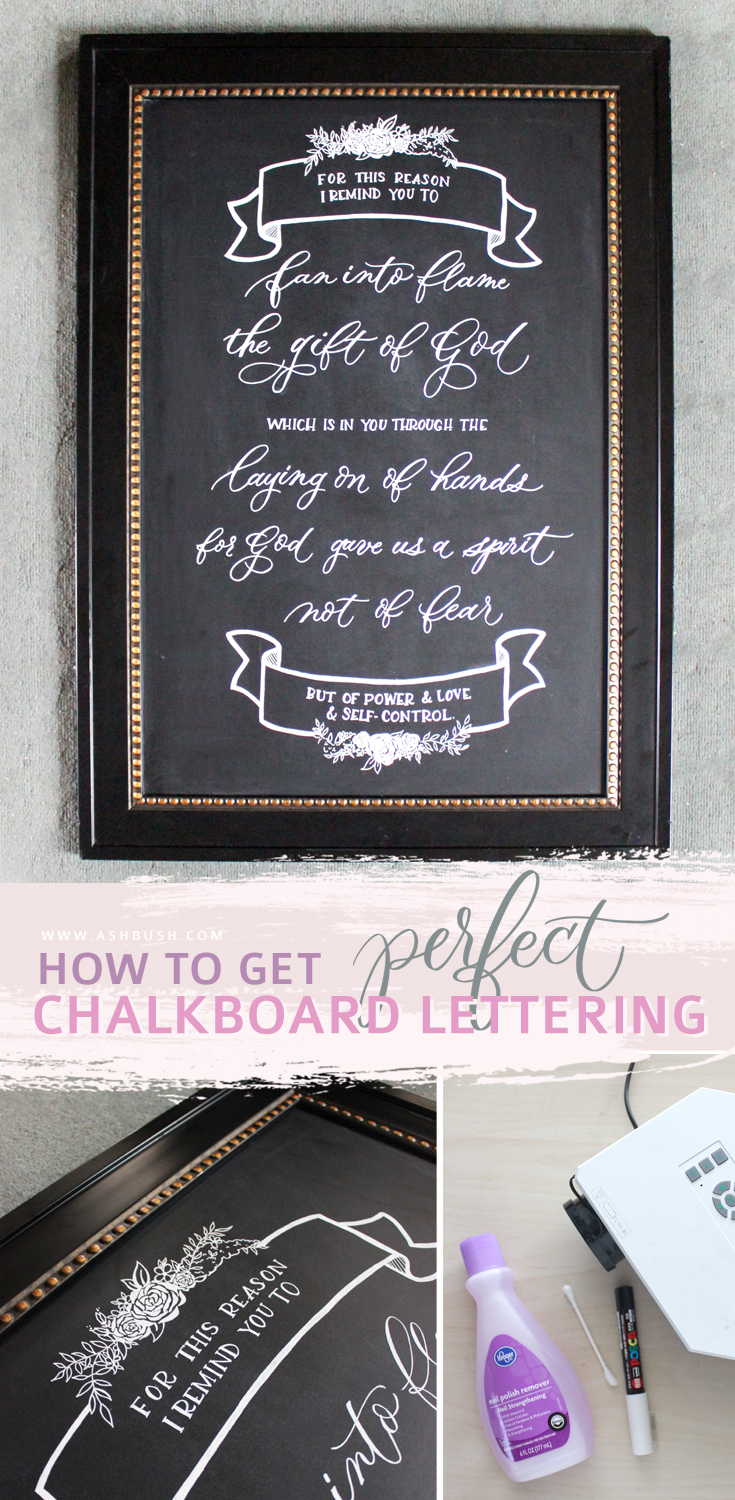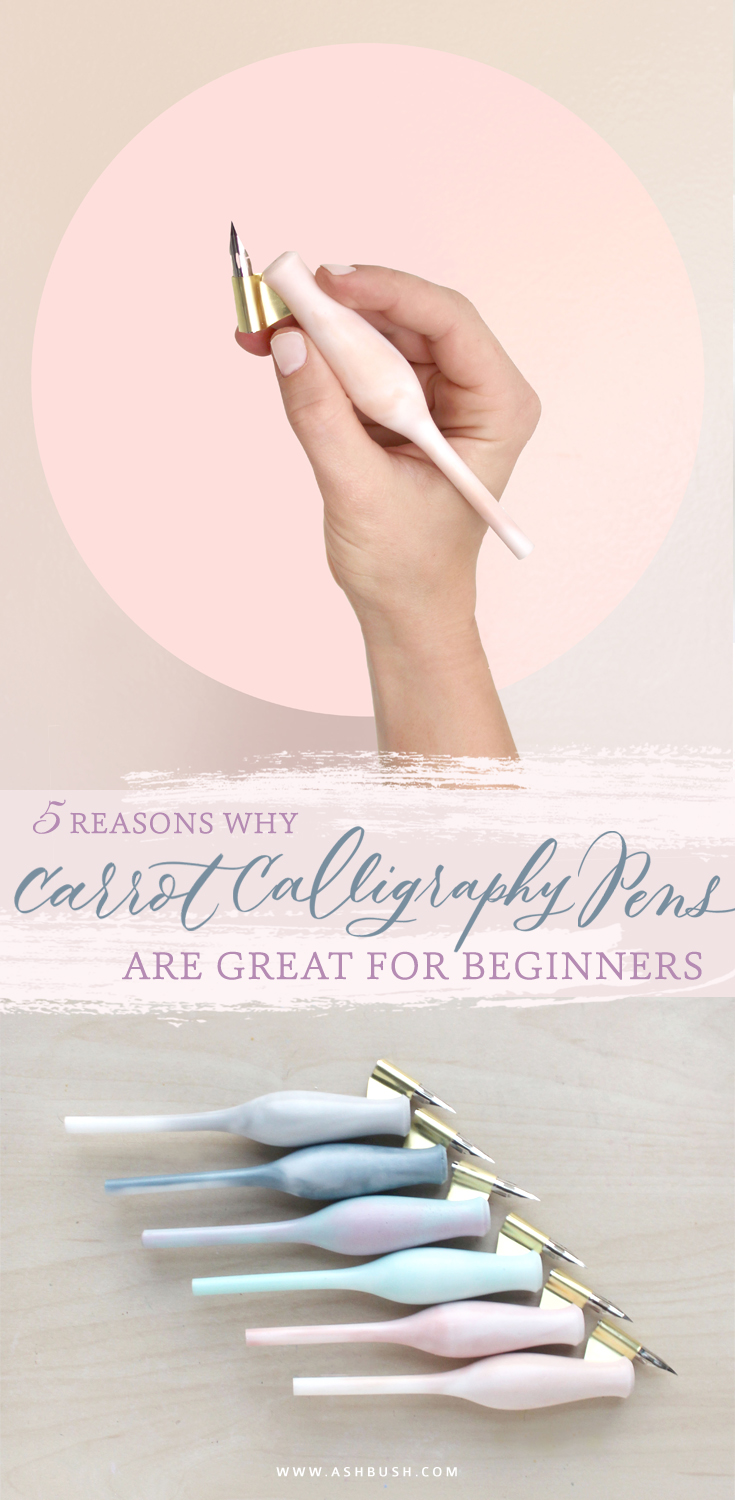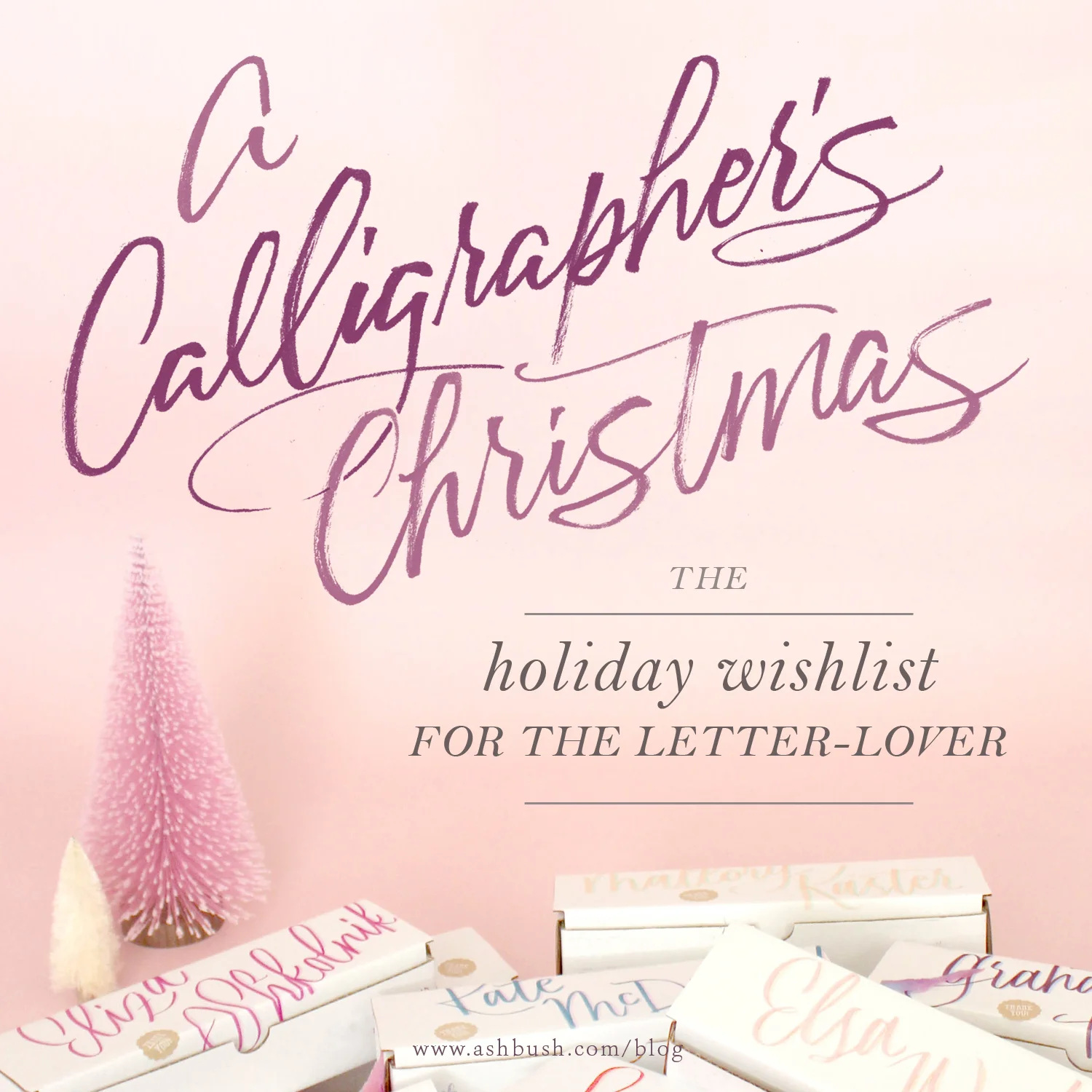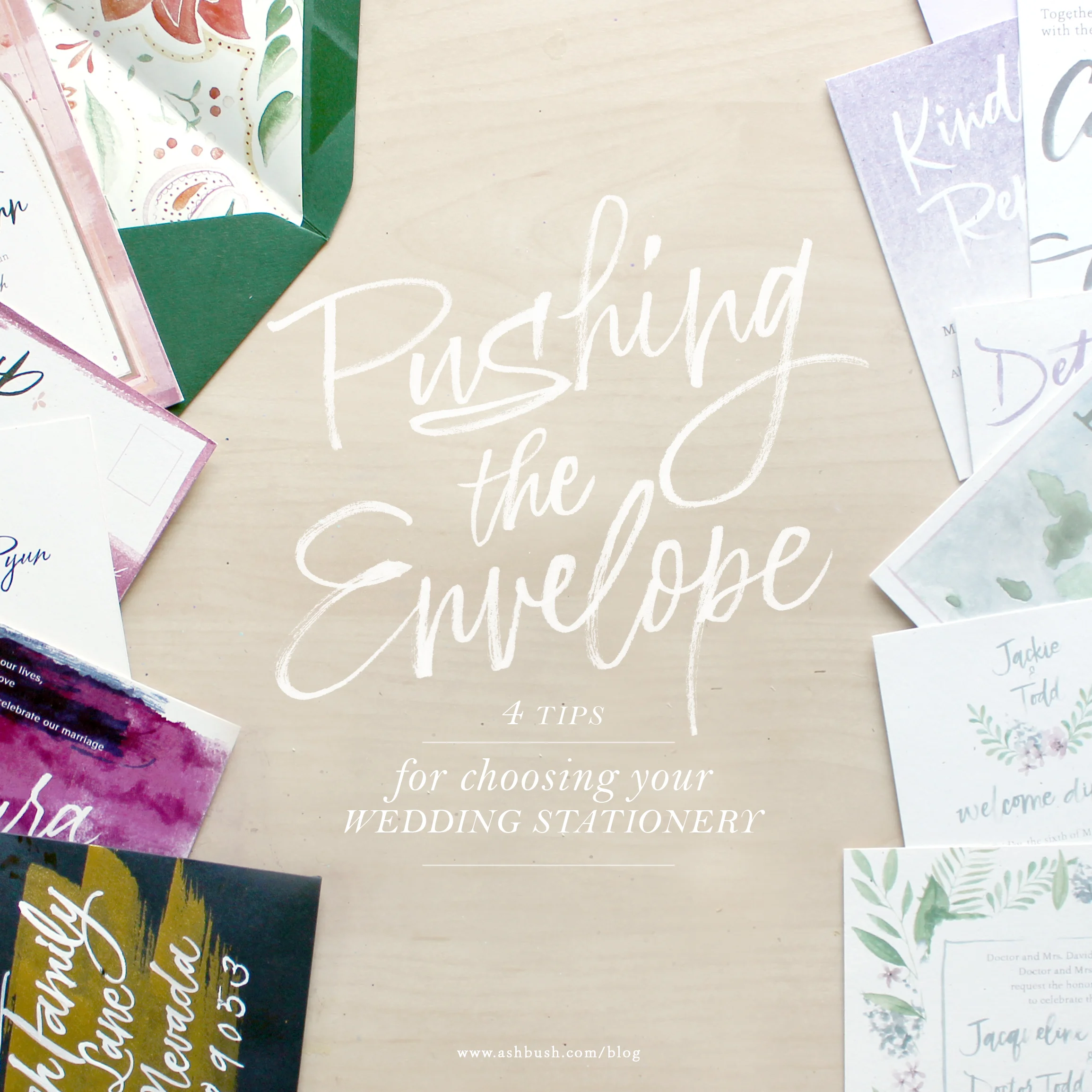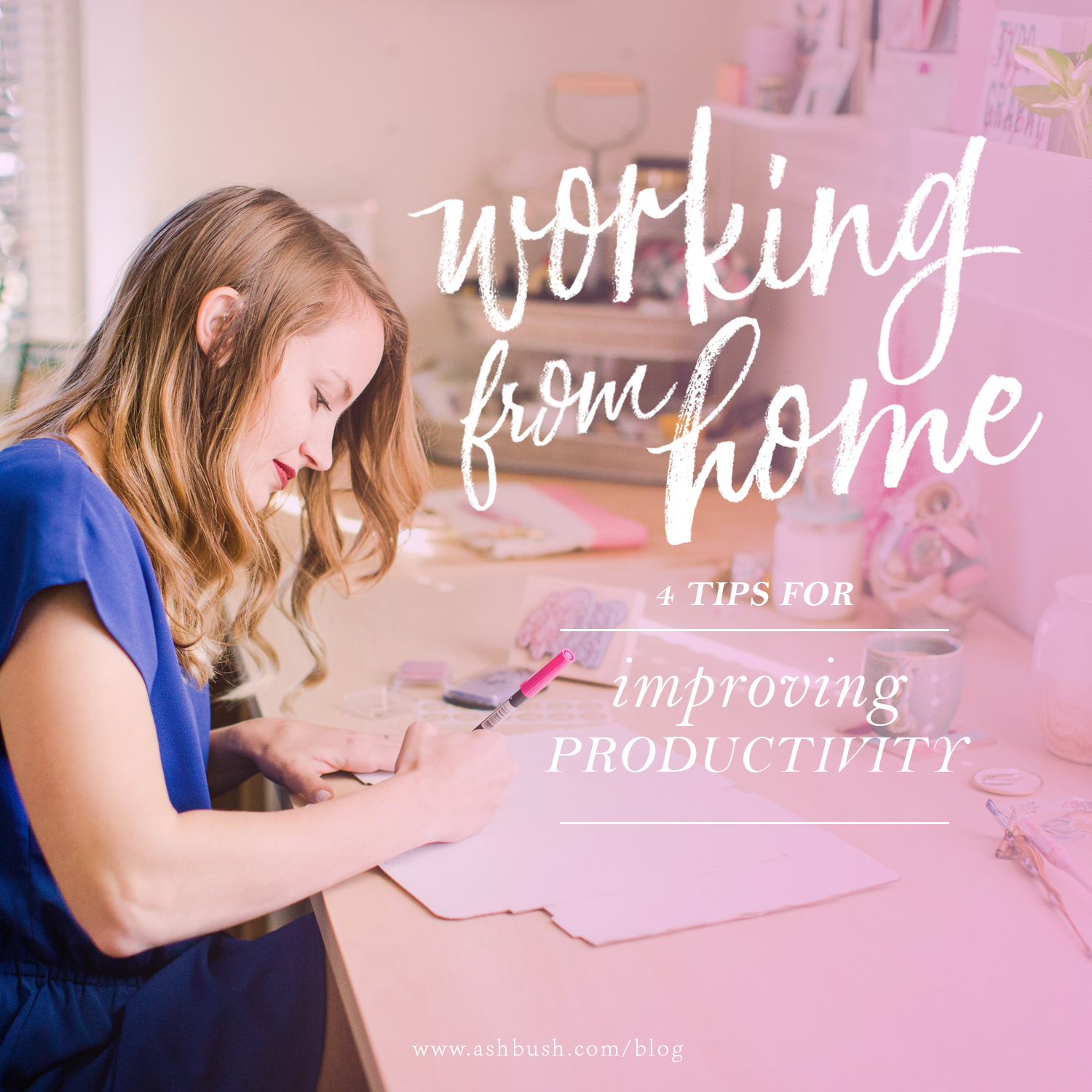Creative Spotlight: Anne Elser
An Interview with Anne Elser
Anne Elser is everything that is right with the calligraphy world. She has learned to focus on the joy to be found in it, for herself, and for others. I've been ogling her work for years. There's really nothing out there like it! What makes it so unique is that you can feel her joy through it. Sometimes we get boggled down with all the technicalities of calligraphy, and while Anne's technical prowess is obvious, it's the emotion behind her work that really makes you to stop and stare. I could, and have, quite literally stared at one of her posts for a good 20 minutes. You just feel something when you look at it! You feel admiration for her skill, adoration of her smart color and layout choices, and an overall contentedness. I truly believe she finds a happiness through her lettering, and it emits from her work in a seriously beautiful way. You can't help but love her for it!
This is an interview you want to take in slowly, sit and chew on it. When she sent me her answers I sat for an hour slowly reading it through, stopping to absorb what she'd said and I still feel like I need to do that a couple more times to get everything out of it. I already knew how obsessed with her work I was, and nothing was ever going to change that, but now I'm obsessed with her as a person, haha! The way she values others is so inspiring. Anne reminds us that at the root of every post and piece of work we see, is a human who deserves to experience the joy calligraphy can bring and we can all work together to encourage that in each other.
I could go on and on, but I'll let you unpack all her wisdoms for yourself. Grab a cup of coffee and settle in, this is a good one!
Fun Facts
Location: Atlanta, GA
"I wish I knew how to…": Sight read sheet music.
If you could spend a day with anyone (from the present or past) who would it be?: My future, wiser self.
What are 5 adjectives you would use to describe your business?:
Nurturing.
Mirthful.
Emotive.
Transparent.
Driven.
Why calligraphy? How did you start on this journey?:
I’ve a BFA in painting from the Cleveland Institute of Art and graduate studies in Graphic Design from Portfolio Center. My love of fluid forms and color relationships began at CIA. Translating those into a love of typography and communication while at PC propelled me forward to take my first Italic calligraphy class in 2000 from Carol Gray at Callenwolde Fine Arts Center.
I distinctly remember sitting in my seat with my first pot of ink, a dinky dip, pad of paper, pen holder, and C2 Speedball broad edge nib. Looking at the rows and rows of practice strokes I was supposed to draw, I thought it all looked so boring, and that I wouldn’t enjoy myself.
How wrong I was.
“I didn’t wait for anyone to tell me I was ready, or good enough… I simply wanted to share what I knew, because I loved it so much. ”
It took ten minutes of feeling the ink glide across that white, thirsty paper, the soothing pull of texture at each downstroke, and that satisfying drink of ink into the well for me to realize that I had found a new more peaceful way to express myself. Calligraphy became a healing medium of focus and peaceful drive. At each practice session, I’d look forward to funneling all my energy into the only thing in my world at that time: a smooth clean rectangle of space, waiting just for me. It is the most addictive and healing practice I know. More effective for me than prayer, it became the place where I found grace.
Everything I loved about creativity fit so beautifully underneath a calligraphic umbrella. Calligraphy became the place where all I had learned came together. I just kept doing it until it became larger than everything else; design, painting, bookbinding, etc.. I used every excuse I could to share what I was learning about calligraphy to my design students in a course I created called Emotive Typography, and I encouraged my clients to choose my hand lettered over typographic solutions. I started accepting wedding work and began offering calligraphy courses at a local art supply store, Binders. I didn’t wait for anyone to tell me I was ready, or good enough… I simply wanted to share what I knew, because I loved it so much.
What are your go-to calligraphy tools of the trade?:
In my calligraphy bag these are the items that I take to every class:
• Barbara Calzolari fabric tool holder
• Heather Held oblique penholders (All others cramp my hand!)
• Double-headed Brause straight holder
• Vintage pointed pen nibs
• Brause broad edge nibs
• Finetec Metallic/Iridescent gouache set
• 025 Black and red Slicci pens
• Dr. Martin’s Bleedproof White
• Gum Arabic & Sandarac
• Stickers and decorative Washi Tape
• Torn pages from vintage books for envelopes and place cards
• Postage Stamps (new and vintage)
• Bookbinding microspatula for mixing ink
• Bone Folder
• #2 bright flat hog’s-hair brush
• PetalPod
• Windsor & Newton Gouache tube paints
• 2mm Lead Holders (one soft/dark and one hard/light)
• xacto knife/blade
• Mars white plastic eraser
• TuffStuff Eraser Stick & Tombow Mono Zero eraser
• Pentel Water Brushes in small and medium
• Viva Paper Towels
I'm obsessed with your style! It holds onto traditional skills while bringing it to life with your unique letter-forms, flourishes and color treatments. How did you come to find your unique lettering 'voice’?:
Thank you!! Things really didn’t come together for me until I began to slow down and pay attention to the standards each class and instructor had to offer.
After that first class I took in 2000, I didn’t take another workshop for a very long time. I just wanted to fly with what I had learned and see where it took me. That all stopped the day I met Barbara Calzolari in a Fractura workshop offered through the Friends of the Alphabet here in Atlanta. The most fabulous piece of advice she gave me was to slow down. I remember her watching me and she held out her hand when I looked up at her, palm up and facing me and she said “Slowly.” She said it again years later at her American Cursive Handwriting workshop at Binders but she used a different word this time, “Stay.”
She took the breath right out of me. And it helped tremendously. From those moments, I realized I hadn’t been listening and absorbing what gifts instructors had to offer. I had been missing a lot of those opportunities to dive into the details that make each stroke and each group of strokes function. Admiring details takes time and patience. Practicing the execution of those details also takes patience. Once I became more patient and present to my work, that unique voice you mentioned above came into play, because it was informed by solid principles of lettering, design, color theory, texture, and composition.
Play is more effective once you’ve gotten out of your own way. But you can’t do that without practice. Practice allows for those effective and learned principles of design in all things to come more fluidly, which allows you to relax enough to channel your own unique voice.
Learn rules so that when it’s time to break them, you’re doing it with intelligence.
“Learn rules so that when it’s time to break them, you’re doing it with intelligence. ”
What hands would you recommend learning before trying to break out on our own and try developing a personal style?:
I really don’t think it matters which hand you learn, only that you choose the one that visually speaks to you the most. I do recommend you give yourself time between classes and workshops to process what you’ve been introduced to.
Finding a group of friends through guilds or classes/workshops to support you on your journey is important. Even an online community can be very inspiring to share your triumphs and questions as you learn.
Flourishing. It's so hard! Any tips or resources for how to make smart flourishing decisions?:
Ovals. Big ones and little ones; practice those.
They’ll make your majuscules stronger. Majuscules are really tiny flourishes. Practice those and when it’s time to draw larger, you won’t feel so lost.
Keep flourishes simple. Everything has a simple, major stem. Even the most complicated majuscules have simple, major stems. Think long, lazy, gentle strokes.
When it’s time to cross a line, do it as perpendicularly as possible.
Feel free to turn the paper as you make strokes so you can draw at a comfortable angle with your hand, wrist, and arm.
Try keeping ovals and lines parallel at similar distances apart. They eye loves to see order and appreciates patterns of repetition.
Practicing simple, small, 3-stroke cartouches is a great way to start flourishing. Once you’re comfortable, you'll want to make them larger and more complicated.
All strokes are in relationship to each other. They play and push against each other. They flirt and dance, they offer comfort and a reliable horizon line so we know where we stand on a page. They challenge each other, they beg for attention, the fill up space with power, passion and awareness. They plead for grace, and they offer balance. They do what letterforms do, but without the burden of having to be spelled correctly. Become friends with them, so you’re not so intimidated by them.
Slow down. A lot flourishes look speedy. Mine are nearly always done slowly. I work at anciently slow speeds. Slowing down affords me the time and awareness to really see what kind of fun I can have, while I am having it.
You're a jack of all trades, painting, book-binding, calligraphy, design, teaching. What brings you the most joy and why?:
Design brings me the least amount of joy, simply because the tool used to execute much of it inspires me the least. Nothing makes my arms and hands hurt more than a computer keyboard or trackpad does. Even using a stylus drains me.
Painting doesn’t feed me unless I am painting letterforms. I am slowly learning to mesh painting and calligraphy and truly - I think that’s my ultimate goal. I’d love to fill a gallery with large calligraphic paintings someday.
Binding a book is all pleasure. After all the design choices have been made about paper, texture, content, and forms, I relish the calm pleasure of stitching through holes and tightening laces. I get to relive my choices as I stitch each signature together. It’s mindless needlework and I love it!
Teaching is the place where I get to be the most generous. My goal there is to promote healing. I also love living like an extrovert for a few hours and speaking to a group of people is really, really fun.
Calligraphy is where I come home. It’s where life calls to me and my hands fill the page with music. It’s where I heal myself and recharge.
You teach calligraphy classes (that I'm determined to attend one day), what has teaching taught you about calligraphy and yourself?:
I am a classic introvert. My time alone is what fuels me. I’d envied the seemingly carefree and expansive lives of extroverts for a long time, until I discovered teaching. Teaching allows me the pleasure of doing a very extroverted performance in a room of people who asked me to be there. It also allows me those very sweet moments when I am with one student and we’re sharing this very intimate experience. It’s the best of both worlds for me. I feel largeness and intimacy at once.
After a class, I’m exhausted, but wired. I’m filled with gratitude. It takes a tremendous amount of courage and optimism for an adult to commit to being a student. I like to think that what I share as an instructor is a giant 'thank you’ for showing up to meet me half way. I try to be as transparent and brave as they are. I am a stutterer when uptight and nervous, so I try to relax and have fun in my classes, because I believe if I am, it’s all the more easy for my students to be.
Above all, I believe as an instructor, I am co-crafting an experience with an audience. I want that experience to be positive, because oh, life is so damn hard and hurts so damn much, right? If I can play a part in enabling a positive experience for a student, then I feel I’ve done my job. The subject we are studying is nearly irrelevant. It’s the gathering, the trust, the intimacy of what and how we are learning that is of primary importance. If I can smooth the way, then I feel good.
While I do try very hard to teach the principles I am learning, (meaning the traditional practices of a hand or technique) I want firstly that my classes promote healing. This means there is no wrong, no right, no standards, no shaming, and certainly no judgement. My struggle as an instructor is to find that delicate balance of learning traditions, without snuffing out the spirit. And if made to choose, I’ll cherish a person’s spirit before forcing them into something that doesn’t speak to them.
“Calligraphy is where I come home. It’s where life calls to me and my hands fill the page with music. It’s where I heal myself and recharge.”
So we're all sitting in one of your classes, what's one time-saving/practical calligraphy tip you'd give us?:
Breathe, listen, and slow down. Also, if you feel a cold wet nose on your knee, it’s my dog Inga. :D
What does a typical work day look like for you?:
I’m a morning person, so I love getting up at 4:30 to sit by the fire and noodle around on my phone or read before my son gets up and I drive him to school.
My workday begins around 9 and ends around 2. I live in a thimble and I’ve just moved my studio out into the living room so I can stretch out my arms and work in a larger space.
If I’ve a private lesson, it’s in the morning and I spend the rest of my workday on commission work.
I teach up to 3 evening classes a week, so I try to fit in a nap before 5, even if for just 20 minutes. If I’ve a super busy day, I schedule two pockets of studio work: one in the morning and one in the early afternoon.
I have two desks/tables for two different kinds of work:
My drafting table faces a window and it’s where all the creative work gets done.
I’ve a darling vintage desk where my computer is and that faces a fireplace. There is where I do the work that schedules classes, markets my work, and estimates the jobs that get done at my drafting table. It’s where I communicate with clients, students, and peers.
If I’m teaching an evening class, I discover another energy burst at 6 and it’s over by 8:30. I’m home again at 9 to unwind or out for a later dinner/drinks with my partner.
Who along your journey has been the most inspiring and influential?:
I’m so grateful to many teachers and students who have inspired me. My students have played a huge role in inspiring me. Their courage, brightness, and business savvy have all propelled me forward. Students both counsel and console me. Honestly, we talk as much about our lives as we do letterforms.
Barbara Calzolari and Heather Held are at the top of my list for daily inspiration. Most of the hands and skills I’ve learned have been through them. There are countless other, though, that I find inspiring and am aching to meet!
What are some unique and interesting characteristics about yourself that you've turned into a strength for your business?:
I think my scheduling nature has helped a great deal in my ability to manifest relationships with clients and manage pockets of time for work and play. (I’m still working on the play part.)
I also think that sticking to doing the things I love, doing them consistently, and being transparent about sharing the work and process, has helped put me on the map, so I’m discoverable. I’ve met artists who are very guarded about their work and territorial about their techniques and who are quick to judge peers by classifying work that is good/better/best/bad into categories that really don’t serve the community.
I want to be part of a community that supports diversity and is curious about change for the future, but also honors people and things that have come before us. I strive for quality, but never, ever, would I allow the concept of creating the perfect letter, impede a person’s desire to feel good. I think that creating an environment of openness, where all levels of experience are welcome, where the table of togetherness is more important than comparing skill levels, where the teacher becomes the student, where we are all the same and it is safe to be yourself - THAT room is my classroom and THAT is the table where I sit and make room for my client’s voice to be heard on the page. My work is my pleasure and I take my pleasure seriously. I think, after a lifetime of being the good girl and being quiet and timid about letting my light shine, and having no community, that finally, at 47, my having a voice after so much silence, is having an impact.
What's one lesson you learned the hard way when it comes to calligraphy or owning a small business?:
1. Take breaks for both the mind and body.
2. Done is better than perfect.
I’ve done awful things to myself by powering through work when I’m tired. I’ve had to learn the hard way to carve time out in my day just for me to do nothing but breathe and be grateful.
Being my own boss has allowed me to craft a career that makes me very happy, but it has not kept me from worrying too much about how it’s all going to shake out. When I’m not busy, I’m grateful for the breather, but I worry I’ll never find work again. When I’m too busy, I’m grateful for the work, but I worry about how it will all get done!
I’m a recovering perfectionist. So! My goal for 2016 is to take better care of myself and better guard my down time. I can easily work without allowing time for decompression. If I’m in charge of my day, why can’t I also be in charge of my mind, and give myself permission to be happy, relax, and love myself, in spite of the chaos going on around me? That is my ultimate lesson, and I think it will take me 40 or so more years to learn it, GodFuckingHelpMe.
Instagram has been pivotal in inspiring and connecting calligraphers from all over the world. What are some of your favorite Instagram accounts?:
My IG account is filled with MOSTLY the calligraphic accounts of my teachers, students, and peers. Too many to list! I’ve really been enjoying getting to know ALL of you and hope to meet in person at the next IAMPETH. It will be my very first!
Below is a list of accounts not directly related to calligraphy that I find both nourishing and inspiring.
@nicolaswilton | @henri_de_toulouse__lautrec | @starwars | @atlantasymphony | @socalitybarbie | @jamesvictore | @parisreview | @barrydraws | @clearcalmspace | #williammorriswallpaper | #paulrand | #tomcarnase
“My struggle as an instructor is to find that delicate balance of learning traditions, without snuffing out the spirit. And if made to choose, I’ll cherish a person’s spirit before forcing them into something that doesn’t speak to them. ”
What's been the highlight of your career so far, and what's next?:
I’ve had some big clients knock on my door in 2015 (I can’t talk about them yet!!) and that was a HUGE thrill!! I’ve also began making connections for taking my workshops on the road - so that’s very exciting, too!
But in my heart, honestly it’s been those quiet moments with a class or private lesson where I’ve felt intimately connected with another person. Here we are at a table sharing one story that is enriched by the personal content of our own experiences. It’s the table of authentic vulnerability that makes me feel like I am not alone, and that my work has more purpose than being pleasant to look at. If it’s what brought us together, it’s just a medium. My greater joy is holding the hand of another person and saying, “yes, me, too.”
What do you want your legacy for your business to be?:
I want for a young person to see what I have done and to know that supporting oneself as an artist is possible. I had to undo a lifetime of voices that told me such a dream could never come true.
In a year or two, I have plans to move into a larger home/studio that will support the gathering of a larger group of likeminded people. I call this place “the Church” not in a religious sense, but a spiritual sense, where we can all gather at the table, glitter pens, exemplars, nibs and brushes in hand, and open ourselves to the next chapter of our journey together.
